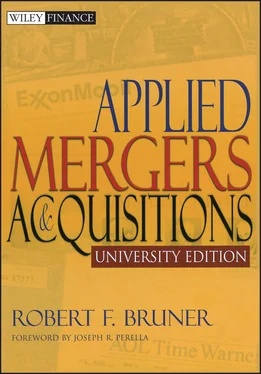ROA = Return on assets.
ROS = Return on sales.
ROC = Return on capital.
*Significant at the 0.99 confidence level.
EXHIBIT 3.9 Excerpted Findings about the Change in Profitability of British Acquirers Following Acquisition
|
Change in Profitability versus Industry and versus Predeal Performance |
Percentage of Observations in Which Change in Profitability Is Negative |
| Year of transaction |
0.148 * |
0.338 † |
| Year +1 |
–0.015 |
0.536 |
| Year +2 |
–0.010 |
0.517 |
| Year +3 |
–0.058 * |
0.527 |
| Year +4 |
–0.098 * |
0.660 † |
| Year +5 |
–0.110 * |
0.642 † |
| Year +6 |
–0.067 |
0.523 |
| Year +7 |
–0.073 |
0.619 |
*Significantly different from zero at 1%.
†Significantly different from 0.5 at 5%.
Source: Meeks (1977), page 25.
The main observation from Mueller’s findings is that acquirers reported worse returns in the years after acquisition than their nonacquiring counterparts—but not significantly so . The most strongly negative results are shown in the right-hand column, notably in the low percentage of the sample that offered a positive comparison. Commenting on the results for all seven countries, Mueller wrote:
No consistent pattern of either improved or deteriorated profitability can therefore be claimed across the seven countries. Mergers would appear to result in a slight improvement here, a slight worsening of performance there. If a generalization is to be drawn, it would have to be that mergers have but modest effects, up or down, on the profitability of the merging firms in the three to five years following merger. Any economic efficiency gains from the mergers would appear to be small, judging from these statistics, as would any market power increases. (Page 306)
Ravenscraft and Scherer (1987) studied 471 acquirers between 1950 and 1977. The novelty in this study was the reliance of the researchers upon a special line-of-business database maintained by the Federal Trade Commission that would permit greater definition of control groups than in previous studies, and more careful assessment of asset values and the impact of accounting method choices. The drawback to the line-of-business focus is that acquisition synergies might occur in other areas of the acquiring firm, and therefore might be missed by this study. Also, the comparison in postmerger years is undermined by misalignment with the merger year. 9 The researchers considered the ratio of operating income to assets. Strengthening the analysis are controls for industry effects, accounting method choices, and market shares. Their principal finding is that profitability is one to two percentage points less for acquirers than for control firms—these differences are statistically significant. Purchase accounting and the entry into new (i.e., diversifying) lines of business are associated with material and significant decreases in profitability.
EXHIBIT 3.10 Excerpts of Findings about Change in U.S. Acquirers’ Profitability Following Acquisition
|
Acquirers: Three Years after versus Five Years before Compared to Two Control Group Companies (% Difference/% Positive) |
Acquirers’ Postmerger Performance Compared to Their Base Industry Peers (% Difference/% Positive) |
Acquirer’s Postmerger Performance Compared to a Projection of Performance Based on a Control Group and Industry Trends (% Difference/% Positive) |
| What it means |
Change in profitability of acquirers compared with a randomly selected nonacquiring firm. |
Change in profitability of acquirers compared with a nonacquiring firm matched on size and industry. |
Change in profitability of acquirers compared with what it would have been if they had followed industry trends. |
| Pretax |
|
|
|
|
|
|
| Return on equity |
–0.084 |
53% |
–0.128 |
48% |
–0.065 * |
3% † |
| Return on assets |
–0.038 |
53% |
–0.049 |
34% |
–0.045 |
3% † |
| Return on sales |
–0.029 |
60% |
–0.034 |
48% |
–0.038 |
3% † |
| After tax |
|
|
|
|
|
|
| Return on equity |
0.011 * |
57% |
–0.002 |
55% |
–0.065 † |
4% † |
| Return on assets |
0.003 |
57% |
–0.001 |
31% |
–0.002 |
17% † |
| Return on sales |
0.003 |
70% ‡ |
0.002 |
58% |
–0.001 |
10% † |
*Indicates significance at 2% level.
†Significance at 1% level.
‡Significance at 5% level.
Source: Mueller (1980).
Healy, Palepu, and Ruback (1992) studied the postacquisition accounting data for the 50 largest U.S. mergers between 1979 and mid-1984, and use industry performance as a benchmark against which acquirers’ performance may be tested. Asset productivity improves significantly for these firms following acquisition, which contributes to higher operating cash flow returns relative to their nonacquiring peers. Acquirers maintain their rates of capital expenditure and R&D relative to their industries, suggesting that the improved performance is not at the expense of fundamental investment in the business. Most importantly, the announcement returns on stock for the merging firms is significantly associated with the improvement in postmerger operating performance, suggesting that anticipated gains drive the share prices at announcement.
FINDINGS ABOUT THE DRIVERS OF PROFITABILITY
The studies yield a number of interesting insights about the determinants of M&A profitability.
Expected synergies are important drivers of the wealth creation through merger. Houston, James, and Ryngaert (2001) studied the association of forecasted cost savings and revenue enhancements in bank mergers and found a significant relationship between the present value of these benefits, and the announcement day returns. The market appears to discount the value of these benefits, however, and applies a greater discount to revenue-enhancing synergies, and a smaller discount to cost-reduction synergies. De-Long (2003) also studied bank mergers and found that investors responded positively to mergers where one partner was inefficient, and where the merger focuses geography, activity, and earnings: All are symptomatic of synergy gains. Chapter 11discusses the valuation of synergies and its impact on share prices.
Value acquiring pays, glamour acquiring does not. Rau and Vermaelen (1998) found that postacquisition underperformance by buyers was associated with “glamour” acquirers (companies with high book-to-market value ratios). Value-oriented buyers (low book-to-market ratios) outperform glamour buyers. Value acquirers earn significant abnormal returns of 8 percent in mergers and 16 percent in tender offers, while glamour acquirers earn a significant –17 percent in mergers and insignificant +4 percent in tender offers.
Restructuring pays. Chapter 6summarizes the research findings on restructurings, divestitures, spin-offs, carve-outs, and the debate over whether diversification pays better than a strategy of focus. The sale or redeployment of underperforming businesses is greeted positively by investors. But whether diversification helps or hurts is a matter of debate today. Informed wisdom these days probably sides with the antidiversification stance, though new findings suggest that it is not diversification or focus that matter. Rather it is continually reshaping the business to respond to the environment that matters.
Читать дальше












